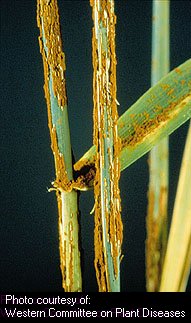Stem Rust In Wheat, Barley And Oats
Stem rust, one of the most destructive diseases of cereals, was responsible for millions of dollars of losses before the introduction of resistant varieties. Stem rust may become a severe problem on barley, as a new race of wheat stem rust (QCC) has been building up for several years and can attack currently recommended varieties of barley. All wheat varieties except winter wheat, have good resistance to QCC.

Host Crops
Different forms of stem rust attack different cereals and grasses. Wheat stem rust can attack wheat, durum wheat and barley (but not oats and rye). Stem rust of rye attacks rye, barley, and quackgrass (but not oats or wheat) but is seldom important on the Prairies. Stem rust of oats attacks only oats, wild oats and meadow fescue. Different strains of stem rust are referred to as races. Cereals and grasses differ in their ability to resist some races.
Biology
Stem rust spores overwinter in the southern USA. A wave of infection usually advances northward by wind-blown spores released from infected wheat or barley plants. Stem rust usually enters Manitoba from late June to mid-July depending on weather conditions and the extent of disease development on cereal crops in the central USA. The disease usually appears on plants in early summer.
After infection, pustules form in 7-10 days. The pustules break open, releasing masses of brown spores that can infect surrounding plants. Temperatures of 20-25 degrees C (68-77 degrees F) favour stem rust development. Rust spots are very small, circular or elongated, and vivid orange-red in colour. Later in the year, the rust pustules darken because of the production of dark-brown-black spores which are the overwintering stage of the rust.
Infected plants usually produce fewer tillers, set fewer seeds per head, and yield small shrivelled seeds with poor milling quality and food value.
Symptoms Of Damage
Stem rust produces dusty, raised reddish-brown, oblong spots on leaves, stems and heads. These pustules become black as the plant matures.
Scouting Techniques
Look for reddish-brown, elongated spore pustules on the stems, leaves, glumes, awns and kernels. The red spore dust may stick to your hands, clothing, and machinery. Later in the season, the pustules produce black overwintering spores.
Economic Thresholds
None available.
Control Tips
Consult your provincial seed guide and if stem rust is a recurring problem, plant resistant wheat varieties. There are currently no barley varieties with resistance to QCC. Seed early maturing varieties. If necessary, apply a foliar fungicide at the very early stage of disease development.
For further information, contact your GO representative.

